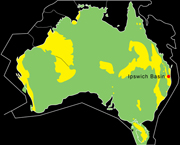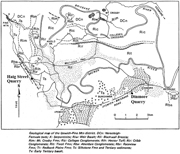Locality Dinmore
The Dinmore Quarry flora
This site is significant in hosting an extremely rich Late Triassic (Norian) flora dominated by corystospermalean seed-ferns, but also including a broad range of other gymnosperm, fern and equisetalean (horsetail) species. These fossils derive from the Blackstone Formation — part of the Ipswich Coal Measures. The site has also yielded fossil insects, branchiopod crustaceans, and a fossil conifer leaf from the quarry reveals one of the earliest examples of insect-induced leaf-mining (Rozefelds & Sobbe 1987). Compression fossils of the same age are found nearby the quarry in tailings dumps from abandoned coal mines. Much younger (Paleogene) leaf fossils are also known in strata unconformably overlying the Triassic beds within the quarry. For these reasons, the quarry has long been used as a teaching site for school and university palaeontological excursions.
Fossils from Dinmore Quarry have been studied for around 100 years. Some key papers dealing with the Triassic fossil flora include those of Shirley (1898), Walkom (1917), Jones & de Jersey (1947), Hill et al. (1965), Pattemore & Rigby (2005), andAnderson& Anderson (2008). Despite these studies, there has been little palaeoecological or palaeoenvironmental work undertaken on the fossil assemblage and there is much potential in using the fossil floras to understand more about the types and intensities of insect-plant interactions in the early Mesozoic.
The SwedishMuseum of Natural History has a substantial suite of Late Triassic fossils from Dinmore collected by Stephen McLoughlin between 1982 and 2007. The only larger collections from this site are held at the Queensland Museum , Brisbane.
Queensland University of Technology geology students excavating fossils at Dinmore Quarry, 2006.
Reference
Hill, D., Playford, G. & Woods, J.T. (eds), 1965. Triassic fossils of Queensland. Queensland Palaeontographical Society: Brisbane.
Jones, O.A. & De Jersey ,N.J., 1947. The flora of theIpswichCoal Measures—morphology and floral succession. Papers from the Department of Geology, UniversityofQueensland 3: 1-88.
Pattemore, G.A. & Rigby, J.F., 2005. Fructifications and foliage from the Mesozoic of southeast Queensland. Memoirs of the Queensland 50(2): 329-345.
Rozefelds, A.C. & Sobbe,I. , 1987. Problematic insect leaf mines from the Upper Triassic Ipswich Coal Measures of southeastern Queensland , Australia. AIcheringa II: 51-57.
Shirley, J., 1898. Additions to the fossil flora of Queensland, mainly from the Ipswich Formation, Trias-Jura System. Bulletin of the Geological Survey of Queensland 7: 1-25.
Walkom, A.B., 1917. Mesozoic floras of Queensland. Part 1. (cont.) The flora of theIpswichand Walloon Series. (c) Filicales. Queensland Geological Survey Publications 257: 1-46.




